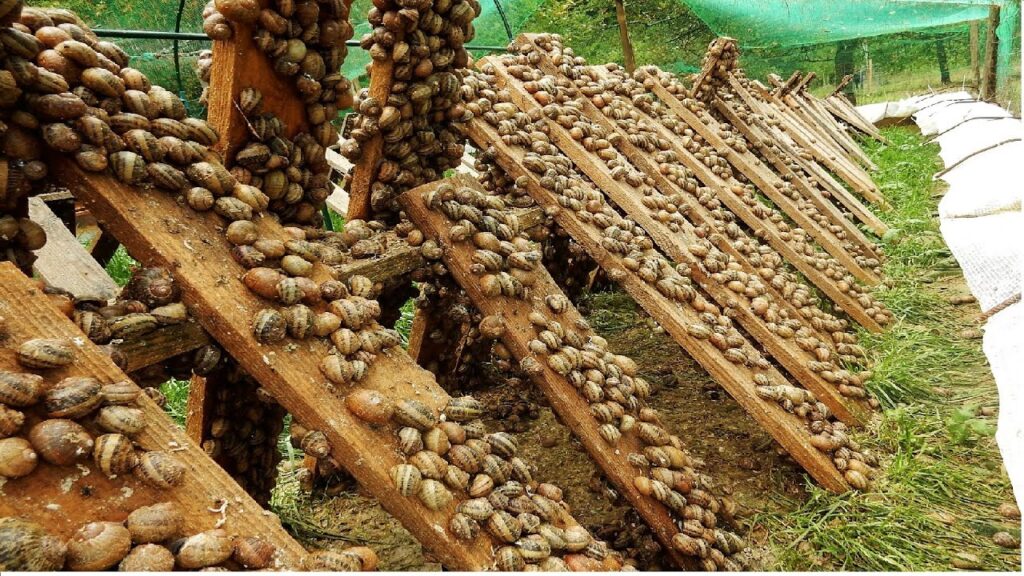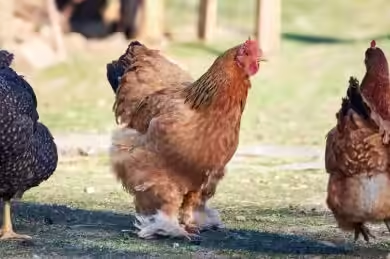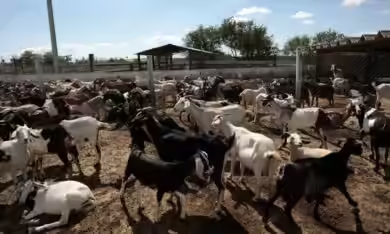There’s no single “best method” for heliculture snail farming. True success comes from finding the right approach for your specific goals, resources, and local area. Based on my years of experience, I’ve seen its importance firsthand.
Ready to explore snail farming techniques? This guide cuts through the noise, offering expert insights and practical advice. You’ll chart your own path to success in this fascinating and lucrative agricultural niche. So, let’s get started!
Why Bother with Snails? Unpacking the Lucrative World of Heliculture Snail Farming
Snail farming is a profitable business. It has high demand for snail meat (escargot). Snails are also used in cosmetics (snail slime) and gourmet products like snail caviar. It needs low startup costs and is good for the environment.
“Why snails?” you might wonder. Snail farming is no mere hobby. It’s a rapidly expanding, profitable venture. It offers surprising benefits. First, global demand for snail meat (escargot) is rising. People now see snails as a great protein source. They’re high in protein, low in cholesterol. Snails contain essential amino acids. They’re a healthy choice for consumers!
But it’s not just for dinner. Snail products go far beyond the kitchen. We’re talking booming cosmetics and pharma. Snail slime, or mucin, is a powerhouse. It’s key in anti-aging creams. It helps skin repair. Snail caviar, tiny white eggs, is a gourmet delight. They fetch premium prices. It’s truly a versatile product!
What’s more, raising snails needs less capital. It requires fewer technical inputs. This is true compared to traditional livestock. You don’t need acres or expensive gear. It’s an accessible entry into agriculture. Even beginners can start. Plus, snail farming is eco-friendly. It has a minimal carbon footprint. It uses less water than other proteins. It can even recycle organic waste. It’s a win-win for your wallet and the planet.
Market demand, local and export, is strong. For example, Nigeria shows immense potential. A 2023 report highlights this. It notes snail farming’s role in food security. It boosts income generation. There’s a strong market for domestic use. Exports go to France and the USA. (Source: ResearchGate – Potential of Snail Farming in Nigeria). This isn’t just a story; it’s a global trend. If you plan well, you can create a profitable business.
Key Takeaways:
- Snail farming offers high profit potential.
- Products include meat, cosmetics (slime), and caviar.
- It requires low startup costs and is eco-friendly.
Charting Your Course: Key Considerations for the Best Heliculture Snail Farming Method
Alright, you’re sold on heliculture. Fantastic! Now, how do we find your “best method of heliculture snail farming”? It comes down to key considerations. These points will guide you in setting up and managing your snail farm.
Which Snail Species Reigns Supreme for Your Farm?
Choosing your snail species is an important decision. It impacts growth, reproduction, and profit. So, who are the top contenders in commercial snail farming?
Globally, a few species are favorites. They’re edible and farm-viable. Giant African land snails are common. Achatina Achatina and Archachatina Marginata lead the market. This is especially true in West Africa. These giants offer large size and meat yield. Achatina Achatina grows quite big. Farmers love their market appeal.
Then there’s Helix Aspersa. It’s the garden snail. This species is popular in Europe. It’s used for traditional escargot. It’s smaller than African snails. But it matures faster. Its reproductive rate is high, a huge plus for consistent output.
I always advise new farmers to consider these key factors:
- Growth rate: How fast will snails reach market size?
- Reproduction rate: Quick breeders mean more hatchlings. This expands your stock faster.
- Adaptability: How well does the species thrive locally? Some snails are hardier.
- Meat quality: Different species have different textures and flavors. Align your choice with your market.
For instance, in many parts of Africa, the larger, meatier Archachatina Marginata is preferred. I once helped a farmer in Ghana switch from Achatina Achatina to Archachatina Marginata. This simple change, driven by local market preference, boosted their sales by 30% within a year!
What Conditions Do Snails Need to Thrive?
Your snail housing location matters. The environment greatly impacts snail health. It affects growth and reproduction. So, what conditions are ideal?
Snails are sensitive to climate. They thrive in warm, humid places.
- Temperature: 20∘C to 30∘\ °C (68∘F to 86∘F).
- Humidity: 75 to 95.
- Wind protection: Strong winds dry their environment. They make snails uncomfortable.
Extreme cold or heat stresses them. This slows growth or causes deaths.
Now, about soil. It’s not just dirt. It’s their home and playground. They lay eggs there! Snails prefer loamy soil. It must be moist but well-drained. It needs rich organic matter. The pH should be neutral to slightly alkaline. Aim for 7.0 to 8.0. Why is this key? Snails absorb calcium from the soil. Calcium is vital for shell growth. Lack of calcium means weak shells. That’s a big problem. Always test your soil first. Amend it with crushed eggshells or limestone if needed.
Finally, think about shade. Snails are nocturnal. They dislike direct sunlight. Your snailery needs ample shade. It protects them from harsh elements. It keeps temperatures stable. Minimize noise and vibration, too. Snails are sensitive to disruptions. A calm, quiet place helps them thrive. Imagine trying to relax in a noisy room; snails feel the same way!
Which Housing System is Best for Heliculture?
This is where the “best method of heliculture snail farming for housing” shines. Your housing choice dictates control levels. It impacts initial investment. It affects daily management. There are three main approaches: extensive, intensive, and semi-intensive. Each has its pros and cons, so let’s look at the different types of snail enclosures.
Extensive System (Outdoor/Open Field)
Imagine your snails living wild and free. That’s the extensive system.
- Characteristics: Snails live on open land. Often, it’s a large fenced area. Human intervention is minimal. They forage naturally for food. It’s basic ‘backyard snail farming.’
- Advantages:
- Low cost.
- Uses natural resources.
- Minimal setup expenses.
- Snails get a natural diet.
- Disadvantages:
- Lack of control is a huge hurdle.
- Vulnerable to predators (rats, birds, insects).
- Extreme weather can destroy your stock.
- Disease prevention is harder.
- Monitoring growth and reproduction is tough.
This method isn’t for high-yield commercial snail farming.
Intensive System (Indoor/Controlled Climate)
On the other hand, the intensive system puts you in charge. You’re the master of their world!
- Characteristics: Snails are raised in a completely controlled environment. This is usually indoors or in specially built units.
- Examples: Cages, hutch boxes, fenced pens within a controlled shed, trench pens, plastic tunnels, greenhouses, or even aquariums for smaller setups.
- Advantages:
- Unmatched control.
- Better disease prevention.
- Predator control.
- Consistent growth rates.
- High stocking densities.
- Maximizes output from a small area.
- Disadvantages:
- Higher initial cost.
- Requires investment in structures and climate control.
- Demands active, daily management.
- Needs more time and technical know-how.
Semi-Intensive System (Hybrid/Combination)
For many, including me, the semi-intensive system is balanced. It’s often recommended. Especially for those starting profitable snail farming.
- Characteristics: This method blends the best. You might breed and hatch indoors. This gives delicate hatchlings a safe start. Then, move the growing snails outdoors. They go to larger, fenced pens for fattening. They benefit from natural conditions. They also forage partially. It’s controlled management with some freedom.
- Advantages:
- Balances natural conditions with controlled management.
- Better predator control and disease prevention than extensive systems.
- Lower operational costs than purely intensive setups.
- Great for beginners.
- Scales well for commercial snail farming.
- Building a Snail Pen/Housing: Proper snail pen construction is vital. This is true for any system.
- Your enclosure must be escape-proof and predator-proof.
- Use robust fencing materials: concrete blocks, corrugated iron, or fine mesh.
- Ensure no gaps. Bury the enclosure bases deep. This deters burrowing predators.
- Ventilation is key. Stagnant air causes problems.
- Avoid overcrowding! Snails need space to grow. Overcrowding stresses them. It stunts growth. It increases disease risk. A general rule is 10-15 snails per square meter. But this varies by species and size.
Key Takeaways:
- Choose species based on growth, reproduction, adaptability, and meat quality.
- Maintain warm, humid conditions (20−30∘°C, 75−95% humidity).
- Use loamy, moist, calcium-rich soil with neutral pH.
- Select housing (extensive, intensive, semi-intensive) based on control needs and budget.
Essential Management Practices for Heliculture Snail Farming: What is the Best Method of Heliculture Snail Farming for Success?
Your snails now have a cozy home. The real work—and fun—begins! Mastering daily management is essential for success in raising snails. Think of it as nurturing a delicate ecosystem.
What’s the Best Diet for Your Snails?
Like us, snails need a balanced diet. It’s vital for their health. The snail feed and snail nutrition are critical. They ensure optimal growth and reproduction.
- Dietary Needs: Snails are herbivores. Their diet should be fresh. Focus on fruits, vegetables, and leafy greens. They love pawpaw leaves, cocoyam leaves, and cabbage. Lettuce, cucumber, and pumpkin are favorites. Ripe fruits like pawpaw and banana are good. I always advise variety. It ensures they get all nutrients.
- Importance of Calcium: This is vital! Calcium builds their shells. Without enough shells, shells are weak. They become brittle. Snails get sick more easily. My preferred sources are crushed eggshells. Rinse and dry them first! Limestone or oyster shells also work. Grind them into a fine powder. Sprinkle on food or mix into soil. Some farmers use fortified commercial feeds.
- Feeding Schedule and Techniques: Snails are nocturnal. So, feed them in the evening. This is best as dusk approaches. Distribute food evenly. Ensure all snails can access it. Avoid piling food up. This prevents spoilage and pests. Only give what they eat overnight. This prevents waste and keeps things clean.
- Foods to Avoid: This is equally important! Never feed snails salty foods. Avoid acidic fruits like citrus. Hairy leaves irritate their skin. Never give them anything toxic. Processed foods, sugary snacks are out. Anything with chemicals or pesticides is a no-go. Stick to fresh, organic produce if possible. I once saw a farmer’s entire batch get sick from feeding them leftover table scraps with salt. It was a tough lesson learned about strict dietary rules!
How Do I Manage Water and Humidity for Snails?
Humidity is crucial for snails’ comfort and health. Maintaining optimal humidity is key. It ensures their activity, feeding, and well-being.
- Maintaining Optimal Humidity: Snails need a consistently moist place. Misting devices, like spray bottles, are your best friend. I mist the pen once or twice daily. This depends on temperature and evaporation. You want moist soil, not waterlogged. Some farmers use shallow water troughs. Be careful not to drown small snails. I remember one humid season when a farmer’s automated misting system failed. Within days, the snails became sluggish. Simply fixing the system and restoring proper humidity for snails brought them right back to life!
- Water Source: What water should you use? Distilled water is ideal. But it’s not always practical for large farms. Boiled and cooled tap water is a good option. It removes chlorine. Rainwater or well water can be excellent. Just ensure they’re clean and contaminant-free. Avoid direct chlorinated tap water. Chlorine harms snails.
How Can I Keep My Snailery Clean and Prevent Diseases?
A clean home means happy snails. Good hygiene is your first defense. It prevents snail diseases.
- Regular Cleaning of Pens: This is essential. I remove uneaten food daily. This stops mold and pests. Change bedding (soil) periodically. Do this every 3-6 months. It depends on density and fouling.
- Preventing the Spread of Disease: Snails can get bacterial infections. Fungal issues and parasites also occur. A clean environment is the best prevention. Proper nutrition helps. Avoid overcrowding. Isolate sick snails fast. This stops the spread. Good ventilation prevents fungal growth.
- Adding Earthworms for Cleanliness: Here’s a neat trick: add earthworms. A few in your snail pens help. They are natural decomposers. They break down organic matter. They keep the soil aerated and clean. It’s like having a tiny cleaning crew!
How Do Snails Breed and Reproduce?
Watching snails reproduce is rewarding. It’s a key part of heliculture. Understanding their breeding habits expands your farm.
- Snail Hermaphroditism and Mating: Fun fact: most edible snails are hermaphrodites. Each has both male and female parts. But they still need a partner to mate. They fertilize each other’s eggs. So, you need at least two snails. After mating, both can lay eggs!
- Egg Laying and Hatching: Snails lay eggs in moist soil. Usually, it’s 1-2 inches deep. Eggs are small, round, and whitish or yellowish. Once laid, I suggest collecting them. Transfer them to a separate hatching box. Fill it with moist, sterilized soil. This protects them from adults. It lets you monitor closely. Hatchlings are delicate. Handle them with care.
- Monitoring Breeding Cycles: Watch your snails closely. Increased mating often means eggs are coming. Monitoring helps you anticipate egg checks. It ensures a steady supply of new stock.
- Separation of Snails by Age/Size: This is a crucial snail farm management practice. As snails grow, separate them. Put them by age or size into different pens. Why? Larger snails can harm smaller ones. They outcompete them for food and space. This ensures uniform growth. It also prevents cannibalism in some species.
How Can I Control Predators and Pests?
Even in controlled settings, snails aren’t fully safe. Predators and pests lurk. They want your hard work as their meal.
- Common Predators: The usual suspects include rats, birds, lizards, and snakes. Some insects, like ants and termites, are threats. Other snails, carnivorous ones, can also be a danger.
- Protective Measures: Secure enclosures are your best defense. Ensure your snail housing has no gaps. No holes where predators can sneak in. Fine mesh or netting keeps out birds. It stops larger insects. For rats, bury the pen walls deep. This stops burrowing. Good drainage deters pests. They thrive in wet conditions. Regular inspection is key. Check for intrusions daily.
When Are Snails Ready for Harvest?
The journey from egg to market-ready snail is amazing. Knowing when and how to harvest is the final step. It completes a successful cycle.
- Growth Rates and Factors Influencing Them: Snail growth varies greatly. It depends on species, diet, and environment. Achatina Achatina might take 12-18 months to reach market size. Helix Aspersa could be ready in 6-10 months. Optimal temperature, humidity, and a calcium-rich diet speed growth.
- Maturity Period: Snails are ready for harvest when their shell lip hardens. It will also curl. This shows they’re fully mature. They’ve reached maximum size for their species. It’s a clear market signal.
- Harvesting Techniques: When harvesting, handle snails gently. Avoid damaging their shells. You can pick them up by hand. Some farmers “purge” snails. They put them in a clean, empty container. No food for a few days. This empties their digestive tracts. It improves meat quality and shelf life. I once helped a small farm implement a simple purging system. Their snails’ shelf life in transit improved significantly. This opened up new, distant markets for them!
Key Takeaways:
- Feed snails fresh, varied, calcium-rich foods daily (evening).
- Maintain high humidity (misting) and use clean water.
- Practice strict hygiene to prevent diseases; consider earthworms.
- Manage breeding by separating eggs and sorting snails by size.
- Build secure enclosures to protect against predators.
- Harvest snails when their shell lip hardens and curls.
Let’s be real: no farming is without bumps. Heliculture snail farming is no exception. But don’t worry! Knowing challenges helps you prepare. You can adapt and use solutions like a pro.
What Common Challenges Might I Face?
So, what are these roadblocks?
- Pests and Predators: Rats, birds, and insects cause havoc. They seek easy meals. Your snails look very tempting!
- Diseases: Like any livestock, snails get sick. Bacterial infections cause shell rot. Fungal issues thrive in dampness. An outbreak can destroy your stock. Manage it swiftly.
- Weather Conditions: Snails are sensitive to climate. Extreme heat or cold stresses them. Long dry spells stunt growth. They can even cause mass deaths. Unpredictable weather is a global concern. It makes outdoor systems vulnerable.
- Market Access and Demand Fluctuations: The snail market is strong. Yet, local demand can change. Finding buyers is a challenge. Establishing market channels can be tough. This is true for new farmers. Pricing can also be an issue. Especially if you’re not well-connected.
- Nutritional Deficiencies: Providing a balanced snail diet is tricky. If snails lack calcium or variety, growth stunts. Their shells weaken. This hurts market value.
- Overcrowding: This is a common beginner’s mistake. Eager farmers maximize space. But overcrowding causes stress. It slows growth. It increases disease spread. It can even lead to cannibalism. It’s a recipe for disaster.
- The “Snail Farmer’s Fatigue”: Here’s a less talked-about challenge: the mental toll. Daily checks, constant humidity monitoring, and dealing with setbacks can be tiring. It’s easy to get discouraged. This “farmer’s fatigue” can lead to neglected pens.
What Are Practical Solutions and Best Practices?
Every challenge has a solution, right? Here’s how to tackle them:
- Fortify Your Defenses: To fight pests and predators, build top-notch snail pen construction. Use strong materials. Concrete blocks, corrugated iron, or fine mesh. Ensure no gaps. Bury the enclosure bases deep. This deters burrowing animals. Regular farm patrols help too. They find and fix entry points.
- Hygiene is King: I can’t stress this enough. It prevents snail diseases. Implement daily cleaning. Remove uneaten food fast. This stops mold and pests. Change the soil or substrate regularly. Especially in intensive systems. Disinfect tools often. A clean home means healthy snails.
- Master Environmental Control: For weather issues, use semi-intensive or intensive systems. Greenhouses or sheds control environment. They shield snails from harsh sun. They protect from heavy rains or cold. Invest in misting systems. Use thermometers/hygrometers. Maintain optimal humidity for snails and temperature for snails. For outdoor pens, plant shade trees. Use shade nets for protection.
- Forge Market Connections: Research your markets first. Local and export. Connect with restaurants and hotels. Talk to distributors and consumers. Farmer cooperatives offer insights. They provide bargaining power. Consider processing snails. Dried snail meat extends shelf life. It reaches more markets.
- Optimize Their Plate: Prevent deficiencies. Provide diverse, consistent snail feed. Supplement with calcium. Crushed eggshells, bone meal, or commercial feed. Rotate food sources. Ensure wide nutrients. Watch your snails. Healthy ones are active. They have strong, smooth shells.
- Give Them Space: Stick to recommended densities. Fewer, healthier snails are better. They grow faster. Avoid crowded, stressed populations. Proper spacing reduces competition. It lowers stress. It greatly cuts disease risk. Think quality over quantity.
- Beat the Burnout: To combat “snail farmer’s fatigue,” build a routine. Automate what you can. Join local farming groups. Share experiences. Celebrate small wins. And take breaks! A refreshed farmer means happier snails. I’ve seen farmers form small local co-ops. They share duties and resources. This drastically reduces individual workload and stress. It’s a significant improvement!
Proactively addressing these challenges builds resilience. You’ll have a truly profitable snail farming operation.
Key Takeaways:
- Protect against predators with robust enclosures and regular checks.
- Prevent diseases through strict hygiene and proper ventilation.
- Control the environment (temperature, humidity) to mitigate weather risks.
- Build market connections early and consider value-added products.
- Ensure balanced nutrition, especially calcium, for strong growth.
- Avoid overcrowding to reduce stress and disease.
- Manage “farmer’s fatigue” by routine, automation, and community support.
The Horizon of Heliculture: Current Trends and Future Prospects
We’ve covered starting and challenges. Now, let’s look ahead. What’s next for heliculture snail farming? What trends shape this industry? The outlook is bright. There’s much room for innovation.
Is Demand for Snails Growing?
The snail market is growing. Demand for snail meat is surging globally. This isn’t just a trend. It’s driven by health awareness. Snails are a healthy, sustainable protein. More people seek nutritious, low-fat options. Snails fit perfectly.
But it’s more than just meat. The market for snail products is expanding. Think snail slime (mucin) and snail caviar. The cosmetic industry uses much snail mucin. It’s for regenerative and anti-aging properties. Snail caviar is a luxury niche. It offers incredible profit margins. This diversification creates more revenue. It makes the snail farming business even more attractive.
Why Focus on Sustainable and Organic Practices?
This trend excites me: sustainable and organic snail farming. Consumers care more about food origins. They want to know how it’s produced. They want safe, natural products. They want to know it hasn’t harmed the environment.
This means fewer synthetic chemicals. It means natural pest control. It ensures humane snail treatment. Organic certification opens premium markets. It commands higher prices. It’s good for the planet. It’s good for your brand and profits. I believe this sustainability focus will only grow. It will be a key market differentiator.
What Technological Advancements Are Shaping Snail Farming?
Believe it or not, technology helps snails too! Advancements make snail farming techniques more efficient. They boost productivity.
Consider automated climate control. It precisely regulates temperature for snails and humidity for snails. This is for intensive setups. Specialized feeding systems minimize waste. Research develops better commercial snail feed. Genetic selection is coming. It aims for faster-growing, more prolific snail species. These innovations boost output. They reduce labor. They make large-scale farms more viable.
Why is Knowledge Sharing Important in Snail Farming?
Finally, training and knowledge sharing are crucial. They drive industry growth. More agricultural institutions, NGOs, and experienced farmers offer workshops. They provide seminars and online resources. These cover starting a snail farm for beginners. They teach effective snail farm management.
Sharing expertise is vital. It empowers new farmers. They get the right snail farming guide and best practices. This cuts trial-and-error. It increases success rates. It also standardizes practices. This is vital for market demands and quality. More people understanding raising snails means a stronger industry.
The future of heliculture snail farming is dynamic. It’s full of opportunity. Stay informed about trends. Embrace innovation. Position your farm for success. It’s an exciting time in the snail business, isn’t it?
Key Takeaways:
- Demand for snail meat and byproducts (slime, caviar) is growing globally.
- Sustainable and organic practices are increasingly valued by consumers.
- Technology (e.g., climate control, automated feeding) is improving efficiency.
- Knowledge sharing and training are vital for industry growth and new farmers.
Frequently Asked Questions (FAQs) About Heliculture Snail Farming
You might have lingering questions. That’s normal after all this talk about heliculture snail farming. I’ve compiled some FAQs. They’ll clear up uncertainties. Especially as you consider starting a snail farm.
Q1: How much space do I need for backyard snail farming?
Honestly, no sprawling estate is needed! A small backyard can be enough. You can start with a few hutch boxes. Or use a small trench pen. Avoid overcrowding. Happy snails need space to thrive!
Q2: What’s the biggest mistake beginners make in raising snails?
From my experience, it’s environmental control. Especially humidity for snails and temperature for snails. Snails are very sensitive. Without consistent moisture and warmth, growth suffers. They also get snail diseases more easily.
Q3: Can I make money from the snail farming business?
Absolutely! The snail farming business can be very profitable. Demand for snail meat is growing. So are snail slime and snail caviar. Success depends on good snail farm management. Choose the right snail species. Reach your market effectively. It’s not quick riches, but dedication pays off.
Q4: How often do I need to feed my snails?
I recommend feeding snails once daily. Evening is best. They’re nocturnal and most active then. Provide enough snail feed for overnight consumption. Don’t leave too much to spoil.
Q5: Is organic snail farming really better?
In my book, yes! Organic snail farming helps the environment. It also attracts consumers. They want natural, chemical-free products. It needs more natural pest control. And organic snail diet sourcing. But market rewards often justify it. You get higher prices and a stronger brand.
Q6: How long does it take for snails to reach market size?
Maturity varies by snail species. Helix Aspersa might be ready in 6-10 months. Larger African species like Achatina Achatina can take 12-18 months. Optimal snail nutrition and consistent conditions speed growth.
Q7: What’s the typical cost of snail farming in Nigeria?
The cost of snail farming in Nigeria can vary widely. It depends on your scale and chosen system. A small backyard setup might cost a few thousand Naira for initial stock and basic materials. A commercial semi-intensive farm could run into hundreds of thousands, factoring in land, construction, and larger stock. It’s best to start small. Then, scale up as you gain experience and capital.
Q8: What are the best types of snail enclosures for different climates?
For hot, humid climates, open-air, extensive or semi-intensive pens with good shade and ventilation work well. In colder or drier regions, intensive systems like greenhouses or indoor hutch boxes are better. They allow precise control over temperature for snails and humidity for snails. Your local climate dictates the best enclosure choice.
Ready to Start Your Snail Farming Journey?
There you have it! We’ve explored heliculture snail farming. From picking species to building snail housing. We covered management and future trends. I hope you feel empowered now. You know about your own profitable snail farming venture.
Remember, no single “best method” exists. Understand your resources and environment. Know your goals. Then choose the right system and practices. Whether backyard or commercial snail farming, consistency is key. Attention to detail and passion help. These amazing creatures will thrive.
I’ve shared insights from years in the field. I used practical experience and research. This gives you a comprehensive snail farming guide. From snail nutrition and calcium for snails to predator control and snail breeding. Every piece contributes to your success.
What are your thoughts? Have you considered raising snails? Or are you a seasoned farmer with tips? I’d love to hear your experiences. Ask any questions. Feel free to reach out with your questions or experiences! Your journey to successful escargot farming starts now.




